Physical Address
304 North Cardinal St.
Dorchester Center, MA 02124
Physical Address
304 North Cardinal St.
Dorchester Center, MA 02124
The Elegoo Saturn was released in mid-2020 as the successor of Elegoo’s Mars Series. It’s basically the big brother to the Elegoo Mars 2 Pro model and the other previous models. It has the same look and even some similar features to them, but there are some significant and very notable changes that make it stand out more.
The first is the 8.9-inch 4K monochrome LCD masking screen which is not only larger than the 6-inch 2K LCD screen found on the Mars series printers, but it also has a higher resolution (3840 x 2400 pixels). The next one is the generous build volume (7.55 x 4.72 x 7.87). It’s larger than what the Mars series offers which allows you to print large objects or multiple full-sized models simultaneously.
The resin vat is equally large (7.6 x 4.7 inches) and much more improved featuring four protruding bumps that help keep the FEP film elevated hence protecting it from getting damaged during cleaning. Size isn’t the only change. The Elegoo Saturn comes with dual linear rails for added stability. It as well includes a network port in addition to the USB port which allows you to print from your computer – the Mars series models only print via a USB port.
Besides enlarging the build plate, the surface hasn’t been changed as it has the same sandblasted texture found on the plate of the Mars 2 Pro and the original Mars model. The light source is also 54 LED Matrix UV lighting which corresponds to that of the Elegoo Mars Pro model. We noted too that the printer lacks an air filtration system, which the Mars Pro and Mars 2 Pro have.
Overall, our time so far with it has been really fantastic. We were impressed with its high-quality output, particularly with the level of detail it was able to achieve when printing both small and large objects. We were pretty impressed too with its generous build volume and significantly shorter curing time (although it’s only slightly faster than that of the Mars 2 Pro).
In all honesty, we did have a good experience printing on this Elegoo Saturn printer and as such, we’re going to give a detailed analysis of what we think about it, especially with respect to the other Elegoo models we’ve tested.
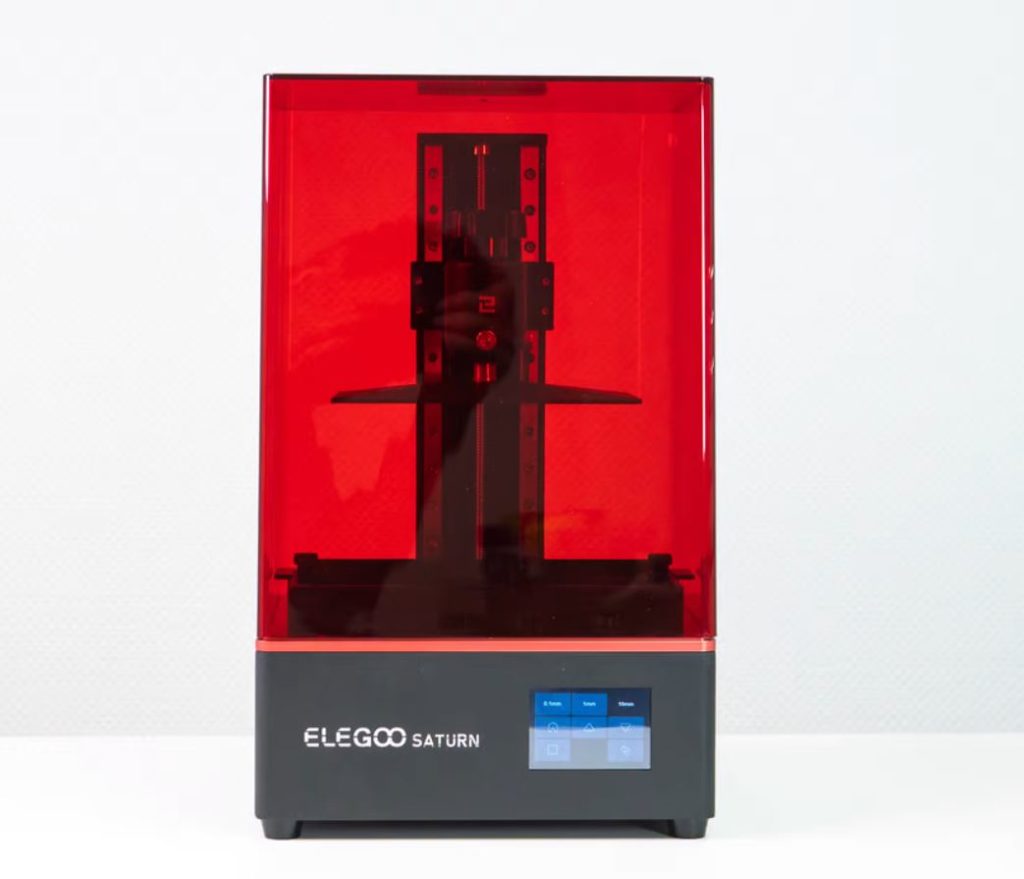
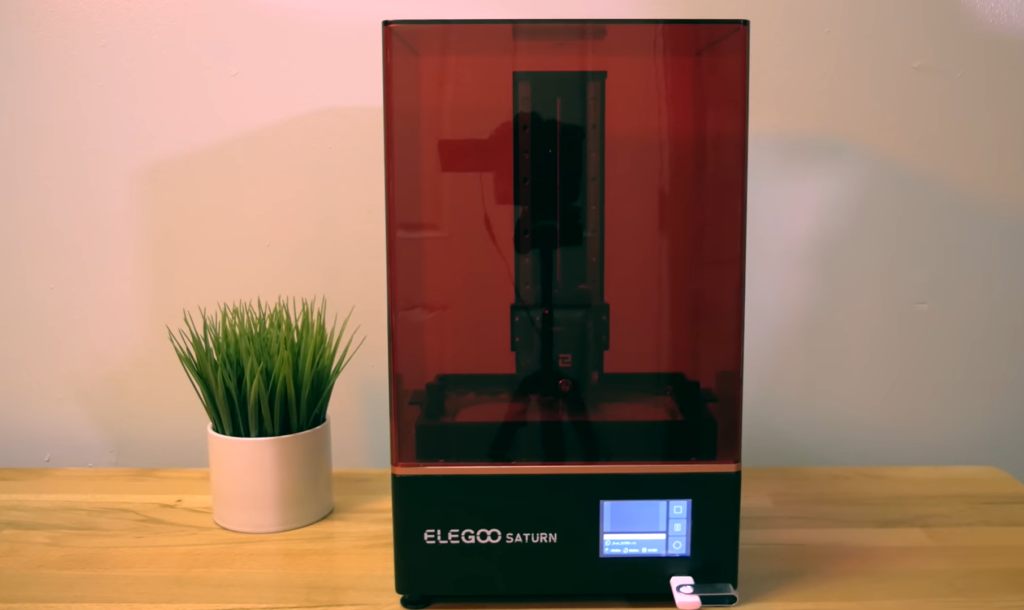
The Elegoo Saturn is quite big in comparison to all the Mars series printers. The whole unit measures 11.02 x 9.44 x 17.55 inches while the Mars Pro and Mars 2 Pro measure only 7.87 x 7.87 x 16.14 inches – it has a larger footprint hence takes up slightly more space on a table than the Mars Pro printers.
When it comes to the design, the Elegoo Saturn doesn’t deviate far from its predecessor. It has the same red acrylic UV hood and black base unit with a 3.5-inch color touchscreen placed at the front.
However, some notable changes set it apart from the Mars series printers. To begin, the USB port has been placed on the right-hand side. For the original Mars model, it was at the back which was awful, the Mars Pro and Mars 2 Pro had it on the front (most convenient), same as the Saturn Beta model.
It generally seems to be Elegoo’s tradition to rearrange the position of the USB port for every machine it releases, and now they choose to put it on the right-hand side which is acceptable and easy to reach than having it at the back of the printer. The company has also added an Ethernet port which offers another connectivity option than just the USB port.
The other key change is the dual linear rails for the Z-axis which is much more steady and stable than the single linear rail used on the Mars printers.
The Saturn comes as well with two cooling fans on the back to cool it (controller board and the UV LED light source) when operating – the other previous models have only one fan.
The resin tank has equally been improved. It has two small hand grips/handles on both sides as well as four bumps/legs on the bottom to help protect the FEP film from getting damaged – these two features are not present on the resin vat of the Mars printers.
Unfortunately, the Saturn doesn’t have any air filtration system like the carbon filter found on the Mars Pro and Mars 2 Pro – it’s actually offered as an optional upgrade. There’s no rubber gasket for the acrylic UV hood either, yet it was provided on the two Mars Pro models to help ensure a tight seal between the hood and the base so as to keeps odors in.
However, despite not having the carbon filter or the rubber seal, the Saturn didn’t really seem to emit much odor than the Mars 2 Pro model during printing. Nonetheless, you have to use it in a well-ventilated room to reduce the danger from inhaling the fumes or get a separate air filtration system to ensure all the fumes are absorbed during printing.
The overall build of the printer is pretty solid just like the other Elegoo printers. It features a sturdy all-metal chassis/base unit and most of the other parts are all sturdy and made of metal including the build platform, the linear rails, and the resin tank (made of aluminum alloy).
The build platform is also held rigid by two large bolts, so it remains in place for a long time once it’s leveled.
The entire machine is generally well made and durable, plus the resin vat/tank doesn’t slide out sideways, instead, it’s removable from the top – which is essential as it helps prevent the LCD panel from getting scratched which was the case with the Mars 2 Pro where several users reported having their LCD screen scratched when sliding the resin vat in or out.
Moreover, the Saturn LCD panel has a screen protector in the form of an extra layer of tempered glass hence it’s not likely to get damaged quickly like that of the Mars 2 Pro which had no protective layer. Still, though, some users reported receiving the printer with the LCD panel either scratched or defective. Ours arrived just fine though and it worked properly without any issues.
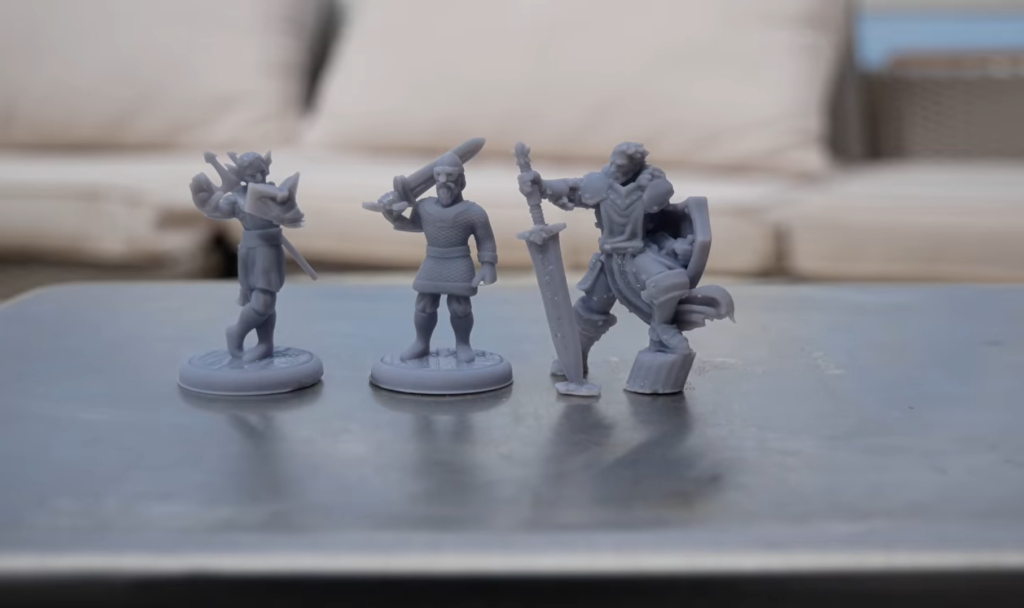
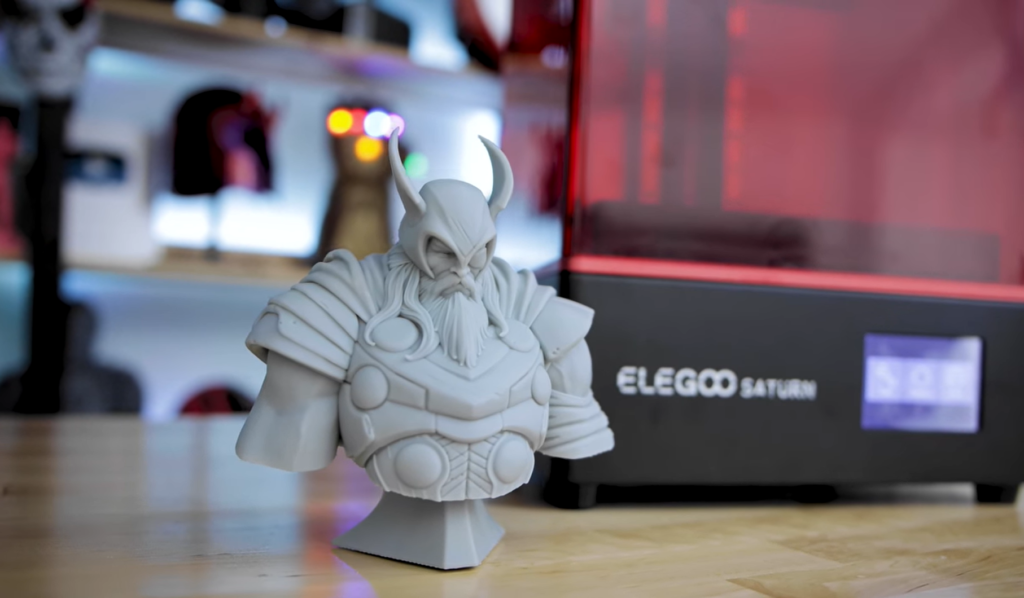
What really sets apart the Elegoo Saturn in contrast to the Mars series printers is actually its printing system which boasts of some major improvements that not only make it quite efficient but also very accurate in the prints that it produces.
The most significant one is the monochrome LCD panel which is now an 8.9-inch 4K screen, a switch from the standard 6-inch 2K screen found on the Mars printers. This new LCD is not only large but it also offers a higher resolution of 3840 x 2400 pixels, which is basically not something you will find on many budget resin 3D printers.
However, even with the increased size and resolution, the Saturn still offers a maximum resolution/layer thickness of 0.05mm on the XY axis which is the same as that of the Mars 2 Pro, meaning that parts printed on either machine, using the same exact settings will be nearly indistinguishable from one another.
The advantage that the Saturn has though is that it’s able to print larger models than the Mars 2 Pro or any of the other Mars printers and they’ll still have the same high level of details thanks to its large monochrome screen and high resolution (3840 x 2400 pixels).
Underneath the screen is the UV matrix light source which comprises 54 UV LEDs. It’s the same light source used on the Mars Pro LCD screen which uses an array of lenses that focus the UV light better behind the screen. The light is distributed uniformly across the entire screen much like in the Mars Pro and Mars 2 Pro, leading to accurate prints with fine details both at the outer edges and the center of the models.
The Elegoo Saturn also features dual linear rails for the Z-axis which is yet another important upgrade from the single linear rail used on the Mars series. The rails are wider and Elegoo has even added extra brackets to the Z-screw arm’s base and more set screws to the top plate.
We were impressed with the overall rigidity of this new rail system. All the upgrades seem to have really helped stabilize the Z screw and as well prevent layer lines often caused by Z-wobble during printing.
As we mentioned earlier, our time with the Elegoo Saturn was a fantastic experience because nearly all the prints we tried turned out successfully which was something we were pleased with, especially the level of detail it was able to achieve for most of the models.
The Saturn comes with a pre-sliced test print on the provided USB drive, which is the same pair of chess rooks included on the flash drive of the Mars 2 Pro but with “Elegoo Saturn” text emblazoned around the bottom. This was our first test print just like in our tests with the other Elegoo printers – we used the default settings and Elegoo’s water washable ceramic grey resin.
The rooks didn’t take long to print and they came out looking lovely. We were very impressed with how the fine details were accurately reproduced. The “Elegoo Saturn” text around the bottom of the rooks, for instance, was clear and well-defined. The fine details like the spiral staircase on the interior were printed with superb precision, plus the overall finish of each model was quite smooth.
The rooks adhered to the build plate a bit too strong making them slightly challenging to remove. This was a familiar issue since we faced the same difficulty with the Mars 2 Pro but it’s mainly due to the solid base of the rooks being printed directly onto the plate. They did eventually pop off the plate using the provided metal scraper and some little force.
For the next print, we chose to do something fun and so we did a futuristic fighter jet which was a pretty large model with lots of detail that we wanted to see how the Saturn Elegoo would reproduce. We used the same water washable ceramic grey resin from Elegoo and again the results were impressive. It printed standing up and as you can see below, all the details around the engine and underneath the plane are almost perfectly reproduced.
On the end of the wings, there’s a really fine line and an air gap which were equally printed very well, so the precision was actually quite good. The model had a lot of supports going down and they all cleaned nicely. There were hardly any pockmarks left on the finished print. Moreover, unlike the rook, the print wasn’t strongly stuck to the build plate – it just popped off easily using the metal scraper.
In addition to the fighter jet and the rook test print, we tried out an ancient statue, David Eastman’s King Thor Bust model. We prepared it using just the default settings in ChiTuBox. We didn’t make any modifications and for resin, we used Siraya Tech fast curing grey resin, which has worked well in our past tests on the Elegoo Mars Pro and Mars 2 Pro.
The King rose majestically out of his bath with stunning details. Everything was basically high-quality, from the beard to the creases and lines on his cloak to the ridges of his helmet – the Elegoo Saturn generally captured all the details spectacularly. It was just a flawless print.
Having successfully printed these three models, we decided to try something complex that would not only really test the capabilities of the Saturn but also take advantage of its large build volume. So we settle for the Notre Dame Cathedral model which is available on MyMiniFactory for free.
The printing process was a long one but the Saturn did finish it and I’d say it was a success, with astonishing detail. We made sure to add plenty of resin in the vat, and it printed it to completion without a refill which was quite impressive too.
We wanted to see how far we can push the printer, especially the large build volume and so we printed multiple miniatures simultaneously comprising of several human miniatures and a mix of detailed creatures. They were 12 parts in total, printing simultaneously, and as we expected, the prints were completed without incident. They turned out beautifully – the details were crisp and the features on most of them could be easily distinguished.
To sum it all, we had a trouble-free printing experience with the Elegoo Saturn and the overall quality of prints as well as the level of detail was very impressive, actually at the same level as the Mars 2 Pro. The most impressive part though is that large prints had the same high level of detail as the small prints, something that Elegoo’s Mars models aren’t able to accomplish.
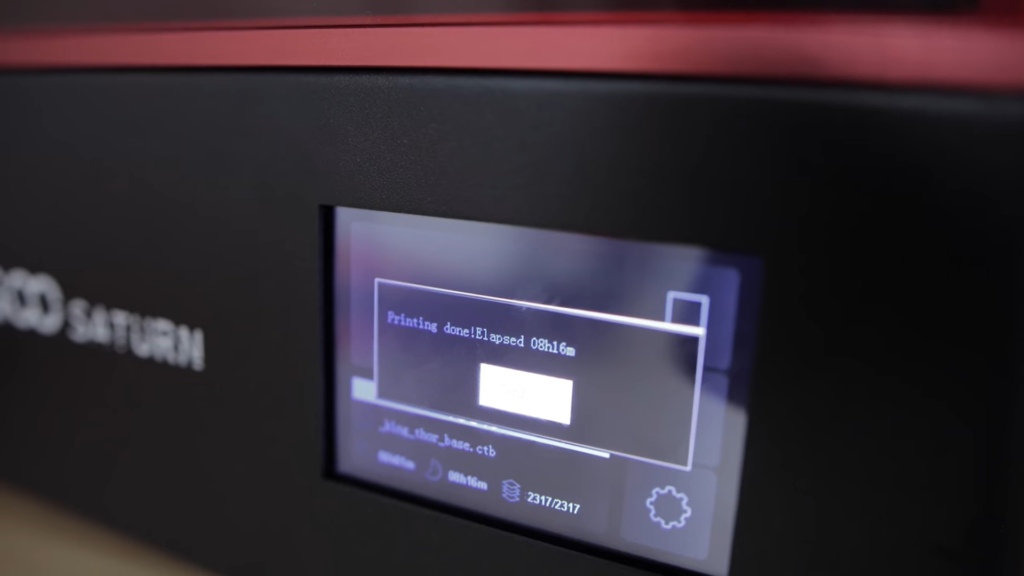
The Elegoo Saturn does shine too in terms of speed and this again is due to its 8.9-inch 4K monochrome display. This screen allows light of high intensity to pass through thereby enabling the resin to cure very fast. It’s able to cure each layer in just 1 to 2 seconds, making it slightly faster than the Mars 2 Pro which takes about 2 to 2.5 seconds to cure prints.
The King Thor bust, for example, took around 10 hours to print, whereas with the Mars 2 Pro it would take slightly over 12 hours to print. We had printed the Notre Dame Cathedral model on the Mars 2 Pro and it was completed in 18 hours while on the Saturn, the print time was around just 15 hours.
Therefore, even with only about 0.5 to 1 second curing time difference, the Saturn is significantly fast, especially when doing long prints. Furthermore, it prints that fast without compromising on print quality which makes it a great option for use in part batch production or other similar applications.
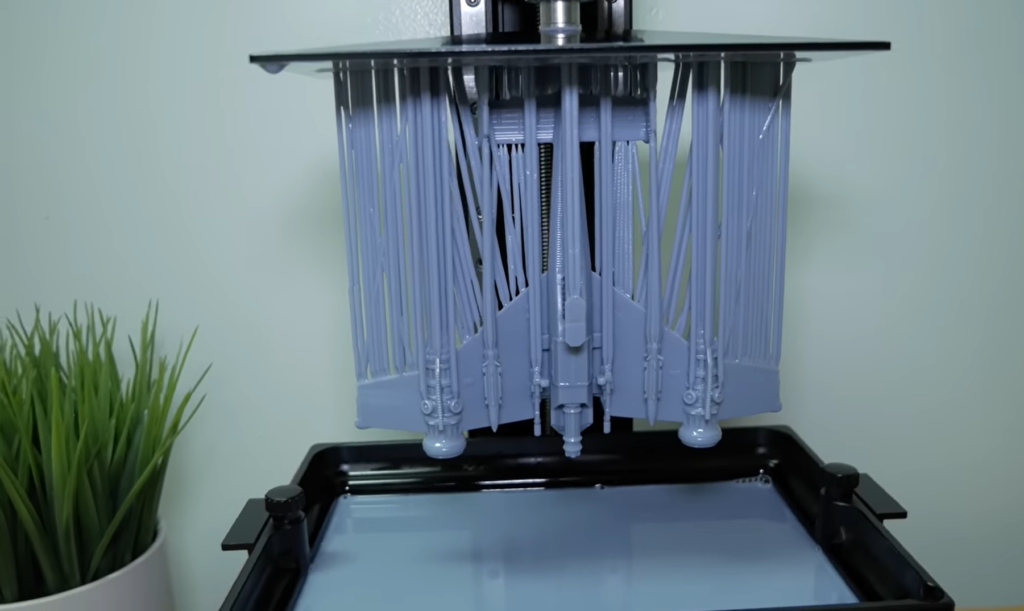
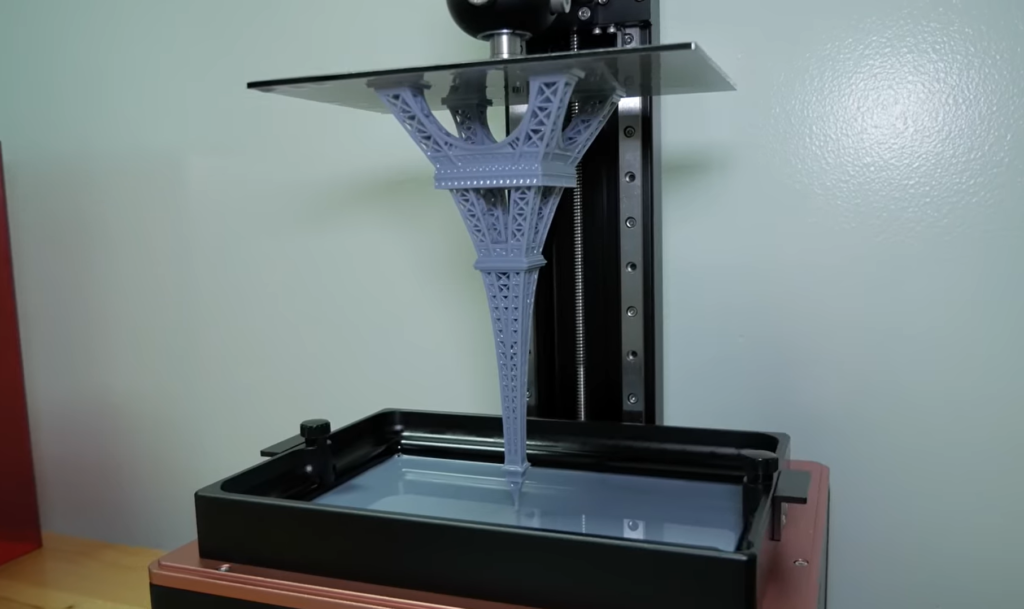
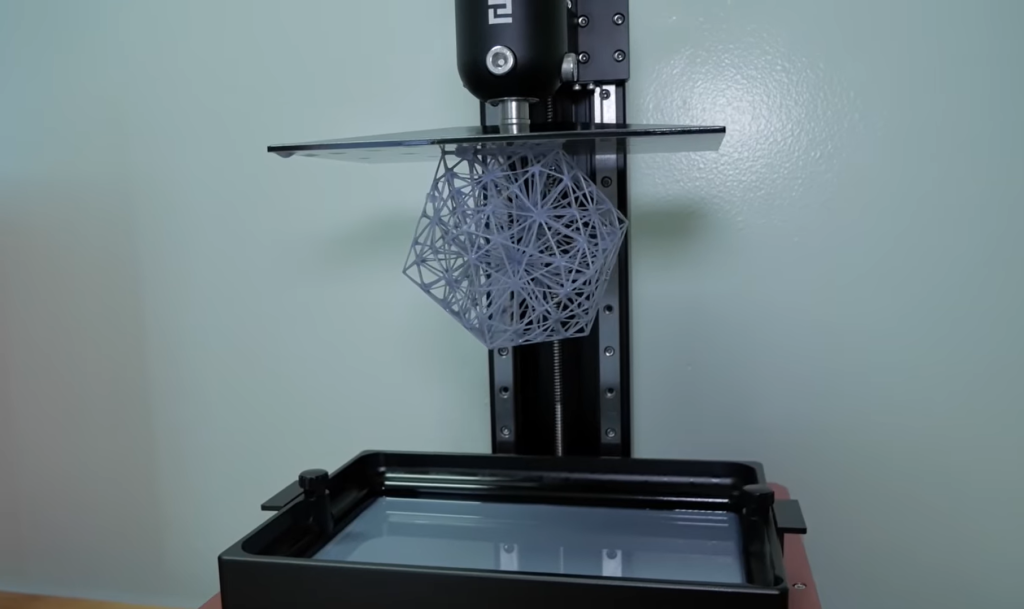
The Elegoo Saturn offers a very generous 192 x 120 x 200mm build volume which is much bigger in comparison to the 120 x 68 x 155mm printing volume that the Mars series models offer. With this added space, this printer can easily handle large, tall prints, like shown in the images above. The best part is that it’s able to print these large models at the same high-level detail as the smaller prints thanks to its 4K monochrome LCD screen.
The large volume also allows you to print multiple smaller full-sized models at the same time like printing miniatures simultaneously, which can remarkably improve your productivity.
The print plate has a coarse, sandblasted finish similar to that of the Mars 2 Pro and original Mars model. The small ruggedness of this surface provides better adhesion allowing prints, especially those pesky first layers to stick pretty well to the plate during printing, which leads to fewer print failures/errors.
We barely had trouble with any of the models we printed with regards to adhesion, except for the included rook test prints which were significantly more difficult to remove. As we had explained, this was majorly due to them having a solid base that stuck tightly to the plate requiring a bit of force to pry off using the provided metal scrapper.
This could be avoided by using a sacrificial raft during printing so as to prevent their bases from being printed directly onto the build plate or having the models suspended from a support structure. However, that was the only issue we experienced during our testing of this Elegoo printer. The rest of the models we printed did stick well to the plate but they didn’t need excessive force to pop them off the plate.
The plate itself has some kind of trapezoidal shape that helps prevent the uncured resin from pooling up on the top during printing, hence allowing it to drip off and not make a mess. Despite this shape though, we did notice that the resin tends to sometimes collect right at the edge of the plate.
A chamfered edge or having the plate tilted a bit more would help prevent this but it’s a relatively minor issue, considering that a majority of the resin drip downwards back into the vat during printing, plus cleaning the edge of the plate doesn’t require much effort.
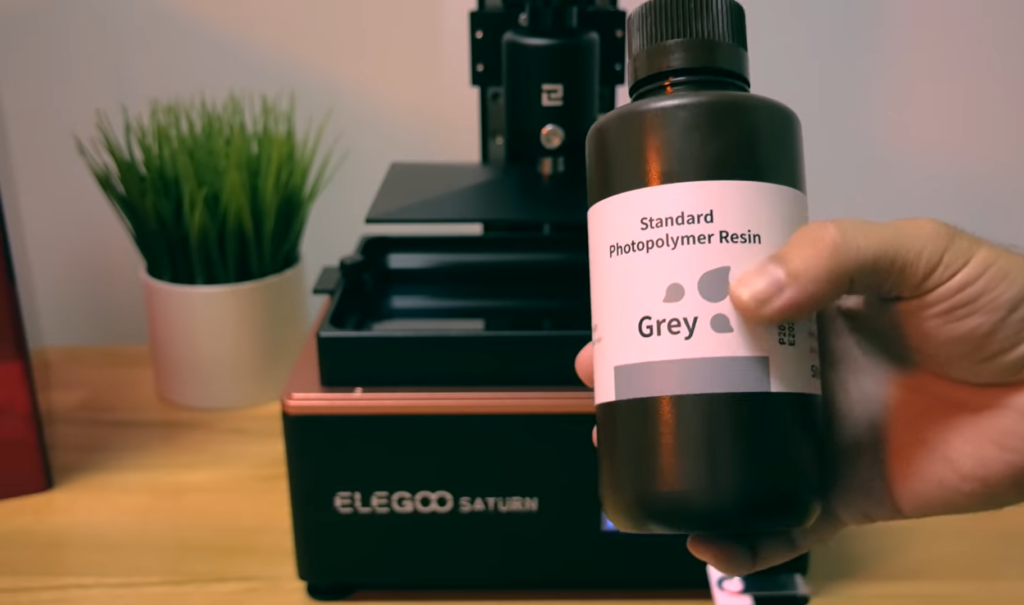
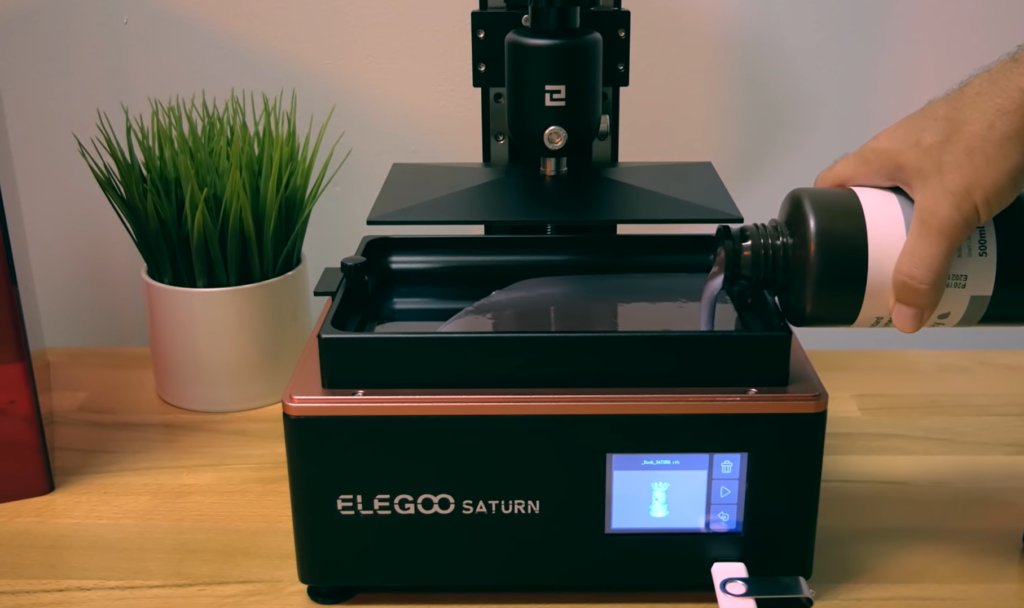
The Saturn can work with a wide variety of 405nm UV sensitive resins both from Elegoo and other third-party brands. In our tests, we printed mainly with the Elegoo water washable ceramic grey resin and the Siraya Tech fast curing grey resin which has become our go-to resin having used it before with great success in our tests with the Elegoo Mars Pro models.
You are basically not limited to only Elegoo’s resins. You can experiment with most of the third-party materials with this printer and still manage to get good results but you’ll have to do a little search to ensure you get the right one because some may not be compatible or may require some tweaking to print with them successfully.
It was nice to see too that the resin tank/vat is larger than the one on the Mars series models, measuring 7.6 x 4.7 inches (192 x 120mm). We noted that the Saturn goes through resin quite fast, so having such a large vat is very convenient, particularly when doing large or long prints.
A max fill line is printed right on the resin vat which is something carried across from the Mars printers and takes away the stress from possibly over-filling and spilling resin, especially with the large build volume, plus the need for more resin.
A spout is as well molded into one corner of the vat to help with pouring out the resin which is a useful feature for those who are frequently draining and replacing resin, or changing vats.
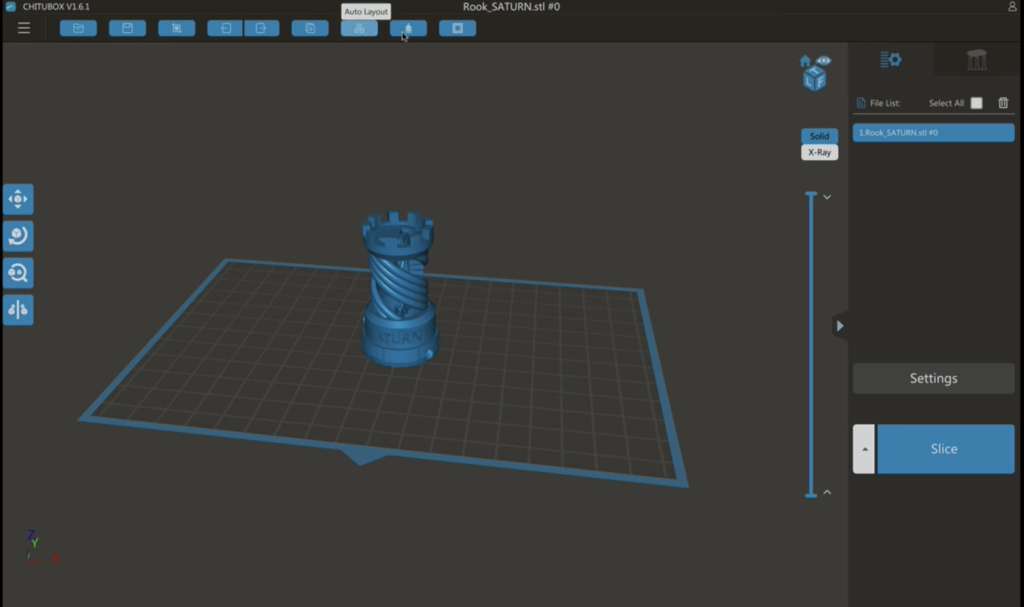
There’s no change in the control panel. It’s still the same 3.5-inch touchscreen with the same intuitive layout and menu items comprising of some basic settings you can perform right from the printer. It’s powered by both ChiTU board and firmware, so it is pretty reliable and easy to use.
The unit comes with a side-facing USB port, so it’s still in a convenient position that’s easy to access, not at the back like was the case with the original Mars. The Mars Pro and Mars 2 Pro have it on the front which is even more convenient.
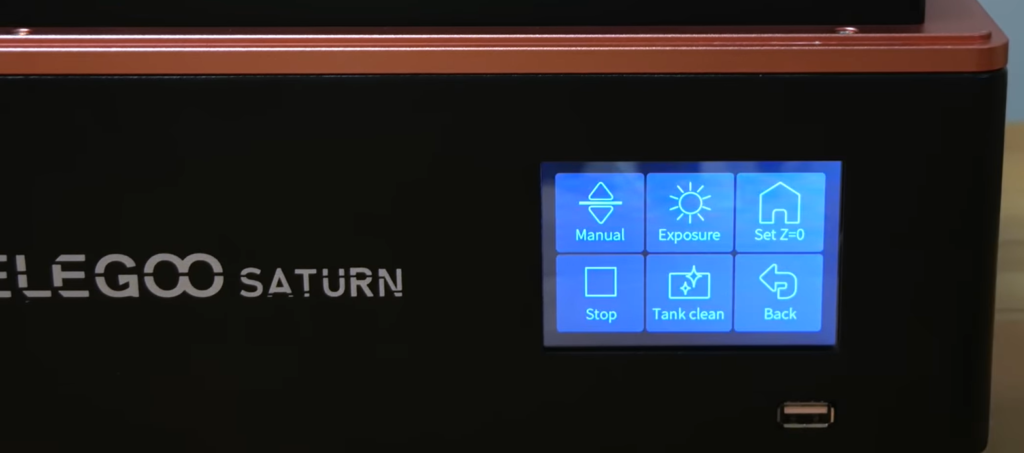
The cool feature though is the inclusion of an Ethernet port at the back which gives you another option of connecting to the printer than just via the USB port.
You can add the printer to a network and print from your computer or even remotely, something you can’t do on the Mars series models. It’s a nice feature that can allow you to use the machine as part of a large volume print firm – you can network it and easily transfer files without requiring an external drive.
The printer works with a ChiTuBox slicer to prepare the models and export files for printing. As we mentioned in our previous reviews of the Mar Pro printers, ChiTuBox is a feature-rich slicer and has all the tools you’ll need, including hollowing models, support structure generation, and more.
You can tweak it to your preferences, plus it includes the profile for Saturn which is a good start point for base settings. The printer is also compatible with the .cbt file extension that both the Mars 2 Pro and Mars Pro support.
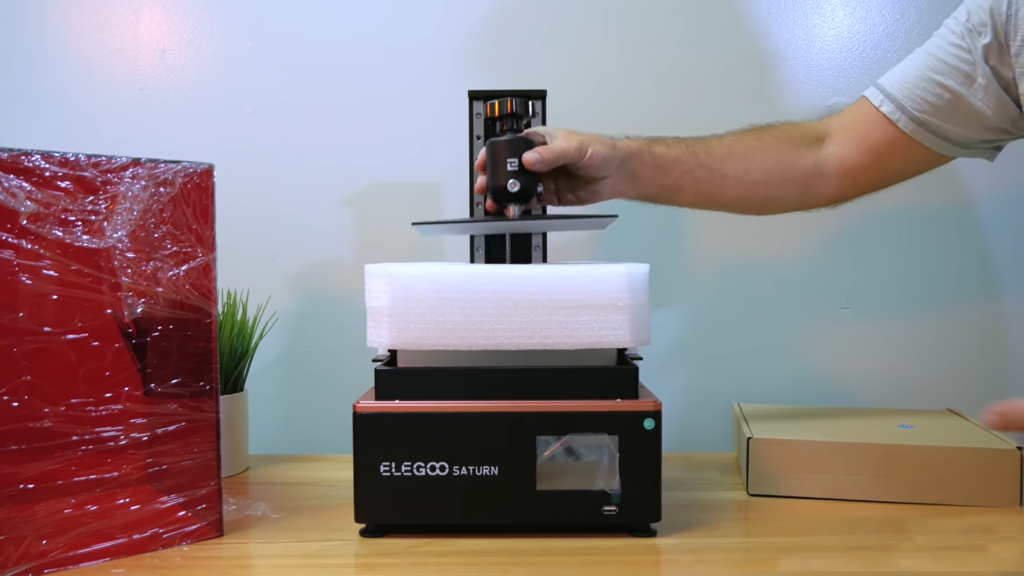
Our Elegoo Saturn came in a well-packed box. It was actually packaged a lot better than the Mars 2 Pro. Elegoo added plastic interior corner protectors as well as hard cardboard edges all around the foam that the printer is nestled in to ensure that it arrives in good shape – which it surely did. There was no single part that was damaged.
Removing the top protective layer revealed the printer, cradled in even more foam to protect the Z-axis drive shaft, the build plate, and the resin tank. The masking LCD screen also came protected with a pair of stickers on it which we had no problem removing, except for the black protective tape that needs to be left, and it’s even clearly stated in the manual so that a new user doesn’t end up accidentally removing it alongside the other stickers.
Setting up the printer is a quick job since it comes fully assembled. It doesn’t require any electrical or mechanical assembly – the only thing left to do is leveling the build platform which is an almost effortless process.
The package includes a leveling paper that’s made of a thin card. It not only has the perfect thickness, but Elegoo has also printed leveling instructions right on it. The instructions are equally included in the provided instruction manual and take you step-by-step through the leveling process which we found to be much similar to that of the Mars 2 Pro. The two rigid bolts keep the build plate solidly in place, so it’s hard for it to shift once it’s leveled.
Many of the tools and accessories are provided with the Elegoo Saturn as were with the Mars 2 Pro. They include the resin tank, two masks, three pairs of nitrile gloves, metal scraper, plastic scraper, measuring cup, ten funnels for filtering resin, tool kit, and Allen keys. A USB flash drive is provided too and it contains a test print, plus the ChiTuBox slicer, and a digital copy of the installation manual. The resin is the only thing not included.
Besides upgrading the printing system, Elegoo has made several improvements on this Saturn model that make cleaning and maintaining it a bit easy compared to the Mars series models.
The most notable one is the improved resin vat. Cleaning resin vats has always been a challenge mainly because they usually sit with the FEP film flush against the table or surface that they are laid down on. Considering how delicate they are, even a slight bump in a table can probably dent or deform them.
Elegoo has equipped the new vat for their Saturn printer with four protruding bumps/legs (one on each corner on the bottom) to combat this. The four legs ensure the FEP film is always slightly elevated when placed on a surface during cleaning. It’s a small feature but one that no doubt helps minimize the chances of the FEP film getting damaged by debris, dust, or even a slight bump on the table.
Besides that, the vat now has a spout in one of its corners to aid in pouring the resin and this too is another useful little feature that makes changing or draining the resin from the vat a bit easy and also less messy.
The other change is the vat loading mechanism. It doesn’t awkwardly slide out sideways like in the Mars 2 Pro, but instead, it’s removable from the top which is much better because there’s little chance of the LCD screen getting scratched, especially if you frequently change resins. The LCD screen itself cleans up easily and it has protective tempered glass. It equally has a longer lifespan compared to the standard LCD screen.